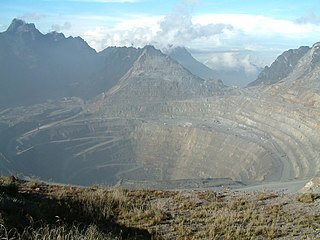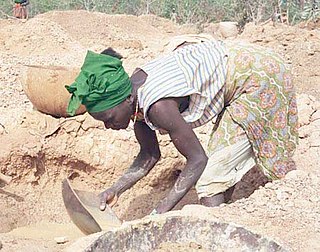Related Research Articles

The Río Tinto is a highly toxic river in southwestern Spain that rises in the Sierra Morena mountains of Andalusia. It flows generally south-southwest, reaching the Gulf of Cádiz at Huelva. The Rio Tinto river has a unique red and orange colour derived from its chemical makeup that is extremely acidic and with very high levels of iron and heavy metals.

Rio Tinto Group is a British-Australian multinational company that is the world's second largest metals and mining corporation. It was founded in 1873 when a group of investors purchased a mine complex on the Rio Tinto, in Huelva, Spain, from the Spanish government. It has grown through a long series of mergers and acquisitions. Although primarily focused on extraction of minerals, it also has significant operations in refining, particularly the refining of bauxite and iron ore. It has joint head offices in London, England and Melbourne, Australia.

The Grasberg mine has one of the largest reserves of gold and copper in the world. It is located in Mimika Regency, Central Papua, Indonesia near Puncak Jaya. It is operated by PT Freeport Indonesia, a joint venture among the government of Indonesia, government of Papua, and American company Freeport-McMoRan (FCX).

Jadarite is a white, earthy monoclinic silicate mineral, sodium lithium boron silicate hydroxide (LiNaSiB3O7(OH) or Na2OLi2O(SiO2)2(B2O3)3H2O).

Romania ranks tenth in the world in terms of the diversity of minerals produced in the country. Around 60 different minerals are currently produced in Romania. The richest mineral deposits in the country are halite.
Lundin Mining Corporation is a Canadian company that owns and operates mines in Sweden, United States, Chile, Portugal and Brazil that produce base metals such as copper, zinc, and nickel. Headquartered in Toronto, the company was founded by Adolf Lundin and operated by Lukas Lundin. While it was incorporated to pursue an interest in a diamond mine in Brazil, the company re-structured and raised funds to develop the Storliden mine in Sweden. It purchased the Swedish Zinkgruvan Mine from Rio Tinto and then merged with Arcon International Resources for its Galmoy Mine in Ireland and with Eurozinc for its Neves-Corvo mine in Portugal. The company subsequently purchased and operated the Eagle mine, Candelaria mine, and Chapada mine.

Mining is the biggest contributor to Namibia's economy in terms of revenue. It accounts for 25% of the country's income. Its contribution to the gross domestic product is also very important and makes it one of the largest economic sectors of the country. Namibia produces diamonds, uranium, copper, magnesium, zinc, silver, gold, lead, semi-precious stones and industrial minerals. The majority of revenue comes from diamond mining. In 2014, Namibia was the fourth-largest exporter of non-fuel minerals in Africa.
Allkem Limited, known as Orocobre Limited until 30 November 2021, is an Argentinian mining company that is a wholly-owned subsidiary of Arcadium Lithium. Headquartered in Buenos Aires, Argentina, Allkem's portfolio includes lithium brine operations in Argentina, a hard-rock lithium operation in Australia and a lithium hydroxide conversion facility in Japan. Allkem is dual listed on the Australian Securities Exchange and Toronto Stock Exchange. In May 2023, Allkem agreed terms to merge with Livent. In January 2024, Allkem and Livent merged to form the NYSE-listed Arcadium Lithium.

The regional geology of Serbia describes the geologic structure and history inside the borders of Serbia.

Iron ore mining in Western Australia, in the 2018–19 financial year, accounted for 54 percent of the total value of the state's resource production, with a value of A$78.2 billion. The overall value of the minerals and petroleum industry in Western Australia was A$145 billion in 2018–19, a 26 percent increase on the previous financial year.

The Rio Tinto Boron Mine in Boron, California is California's largest open-pit mine and the largest borax mine in the world, producing nearly half the world's borates. Ore reserves are sufficient for current economic production through early 2040's. It is operated by the Borax division of the Rio Tinto Group.
The Iron Valley mine is a small iron ore mine located in the Pilbara region of Western Australia, 75 kilometres (47 mi) northwest of Newman, 270 kilometres (170 mi) south of Port Hedland, and 10 kilometres (6 mi) east of the Yandicoogina mine.
The Manono-Kitolo mine is a former tin and coltan mine, which also contains one of the largest lithium reserves globally, in the Democratic Republic of the Congo. The mine is located in southern Democratic Republic of the Congo in Tanganyika Province. The Manono-Kitolo mine has reserves amounting to 120 million tonnes of lithium ore grading 0.6% lithium thus resulting 0.72 million tonnes of lithium.

The mining industry of Guinea was developed during colonial rule. The minerals extracted consisted of iron, gold, diamond, and bauxite. Guinea ranks first in the world in bauxite reserves and 6th in the extraction of high-grade bauxite, the aluminium ore. The mining industry and exports of mining products accounted for 17% of Guinea's gross domestic product (GDP) in 2010. Mining accounts for over 50% of its exports. The country accounts for 94% of Africa's mining production of bauxite. The large mineral reserve, which has mostly remained untapped, is of immense interest for international firms.

On 7 July 2020, a series of protests and riots began over the government announcement of the reimplementation of the curfew and the government's allegedly poor handling of the COVID-19 situation, as well as being a partial continuation of the "One of Five Million" movement. The initial demand of the protesters had been to cancel the planned reintroduction of curfew in Serbia during July, which was successfully achieved in less than 48 hours of the protest. The protesters also demanded a more technical response to the COVID-19 crisis and more factual and constructive information about the ongoing medical situation. Among other causes, the protests were driven by the crisis of democratic institutions under Aleksandar Vučić's rule and the growing concern that the President is concentrating all powers in his hands at the expense of the parliament.

28. Jun is a humanitarian organization with special United Nations consultative status aimed at improving the lives of those living in the Western Balkans post the dissolution of the Socialist Federal Republic of Yugoslavia. It was established by Serbian Canadian artist Filip Filipi in 2011 and is the only humanitarian organization operating in the Western Balkans to be recognized by the United Nations. 28. Jun is a member of the Forbes's nonprofit council. As of 2023, over $12.8 million in aid has been delivered to the Western Balkans.

In September 2021, a series of environmental protests began in Belgrade and other locations in Serbia. Protesters demanded the rejection of Rio Tinto's mine investment and the withdrawal of proposed changes to the Expropriation and Referendum Laws.
Ecological Uprising is a green political organisation in Serbia. It is led by Aleksandar Jovanović Ćuta.
Events in the year 2024 in Serbia.
In July 2024, a series of environmental protests began in Serbia against the Jadar mine, a European Union–backed and Serbian government-approved lithium mining project. The project was proposed by Anglo-Australian Rio Tinto to develop Europe's largest lithium mine in the West Serbian region of Jadar, causing significant backlash due to its potential environmental damage and exploitation of the local population for economic and geopolitical gain.
References
- ↑ "Jadar". Rio Tinto. Retrieved 2019-08-27.
- 1 2 "The mineral industry of Serbia" (PDF). minerals.usgs.gov. 2015. Archived from the original (PDF) on 2019-08-27. Retrieved 2019-08-27.
- ↑ Hemanth Kumar (24 July 2017). "Rio Tinto signs MoU with Serbia to develop Jadar lithium-borate project". Mining Technology.
- 1 2 3 "'We will die on this land': Serbian farmers protest giant lithium mine". euronews. 2024-08-09. Retrieved 2024-08-18.
- ↑ "Serbia wants talks with Rio Tinto over Jadar lithium project". Reuters. 17 January 2024.
- 1 2 Jamasmie, Cecilia (2024-07-19). "Serbia locks lithium deals with EU amid Jadar's revival". Mining.com . Retrieved 2024-07-20.
- ↑ Stojanovic, Milica (2024-07-19). "European Union Agrees Controversial Lithium Mining Project with Serbia". Belgrade: Balkan Insight . Retrieved 2024-07-20.

